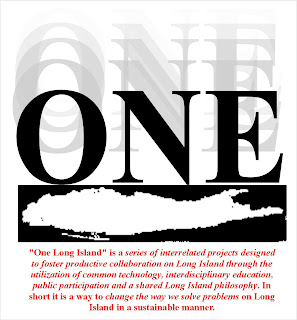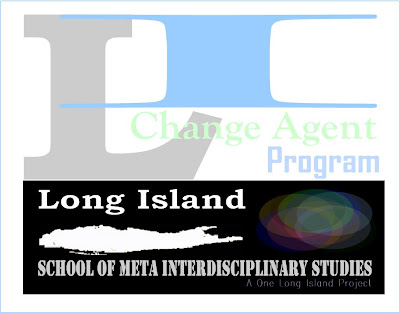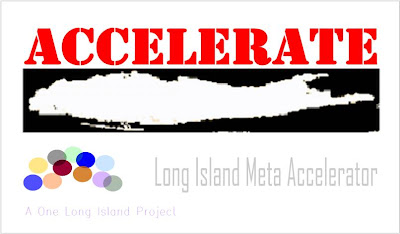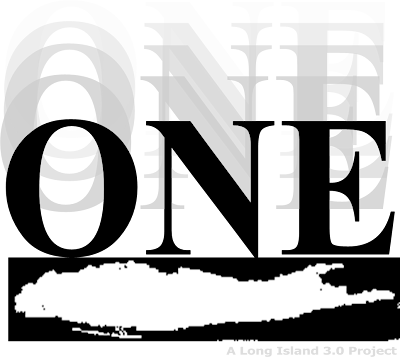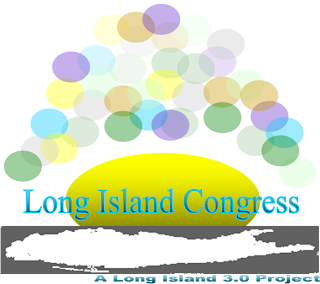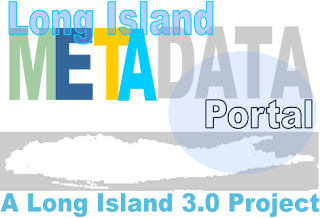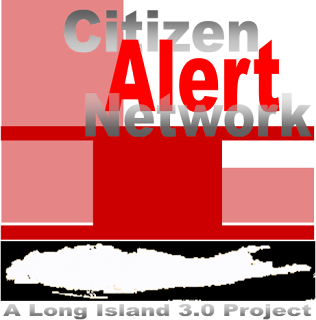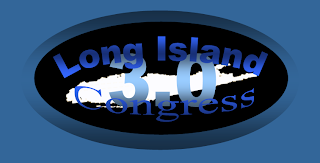A lot of great ideas here.
Much of it is right on point with our Long Island 3.0 project.
We'll do a more complete analysis and specific integration in future posts, beyond what we've already accomplished.
More here on how people are adopting a different method of learning and acquiring knowledge.
Thursday, May 31, 2007
More on building trust ...
Good article on what it takes to build trust and get things done in a "knowledge economy."
Trusting the "process" is essential in building a Long Island 3.0 model.
Trusting the "process" is essential in building a Long Island 3.0 model.
More old stuff...
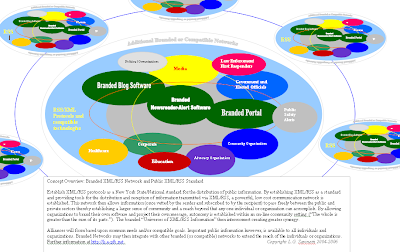 I was clearing out some old files and I came across this chart.
I was clearing out some old files and I came across this chart.It represents how autonomous or related entities (organizational, conceptual, advocacy based etc.) can maintain their autonomy and identity while cooperating and interacting with the larger world through the utilization of XML technology.
Just one part of the puzzle.
Labels:
collaberative,
dynamic information,
Long Island reorganization,
rss,
xml
Wednesday, May 30, 2007
Meta-Editorialism: Part Three
 Good article on the concept of "crowd sourcing" and its application for online marketing.
Good article on the concept of "crowd sourcing" and its application for online marketing.While the information here is probably a little too broad for our present purposes, it does point what direction the web is headed and how it may affect the method by which the public interacts with media and government.
It also reinforces the idea of a multi-disciplinary approach to problem solving we talked about in previous posts.
Whether we are marketing products or marketing ideas, opinions and concepts, the processes for distributing the information are pretty similar.
Tuesday, May 29, 2007
Long Island Decision Model: Part Three
 Here's a good article on something called "Boyd Cycle Theory" and how to anticipate and react to changes in your environment.
Here's a good article on something called "Boyd Cycle Theory" and how to anticipate and react to changes in your environment.While not exactly on point for our purposes, it does offer useful guidance in the area of how to create good public policy in a rapidly changing environment.
This is also an interesting article on the use of artificial intelligence and the creation of public policy.
A Common Data Architecture for Long Island
We've discussed previously on multiple posts the need to share data on Long Island (and to import relevant data from outside Long Island) and to analyze all in a rigorous and coordinated manner.
One possible method for attempting to gather and organize all relevant Long Island data is perhaps to develop universal or standard Long Island Metadata tags.
Another is to create a completely unique Long Island data architecture model which nevertheless is open and compatible with other data sources.
Then we ("Long Island 3.0") must partner with a flexible company or series of flexible companies in designing the proper methodology for vetting, accessing and analyzing this data (metadata) so that we arrive at a reasonable series of policy choices from which to decide.
While this may seem to be a monumental task, it is possible to accomplish this all in a reasonably short period of time.
All we need is leadership, focus and cooperation. The money, intelligence and organization is already in place to achieve the task at hand.
One possible method for attempting to gather and organize all relevant Long Island data is perhaps to develop universal or standard Long Island Metadata tags.
Another is to create a completely unique Long Island data architecture model which nevertheless is open and compatible with other data sources.
Then we ("Long Island 3.0") must partner with a flexible company or series of flexible companies in designing the proper methodology for vetting, accessing and analyzing this data (metadata) so that we arrive at a reasonable series of policy choices from which to decide.
While this may seem to be a monumental task, it is possible to accomplish this all in a reasonably short period of time.
All we need is leadership, focus and cooperation. The money, intelligence and organization is already in place to achieve the task at hand.
Thursday, May 24, 2007
XML Feed Lists for Public Information and Alerts
In previous posts we've talked about the need to have all public information (or, at a minimum, public alerts) available through XML/RSS technology.
We've also explored the need to make all public information available through multiple platforms and on a variety of devices.
Of course we can not force individuals to receive information they don't want to receive. However, at a minimum, there should be a list of XML Alert feeds available, simple instructions on how to use them and accessibility to free devices for those few who do not already have the ability to receive the information.
Alerts should be available from, among others, all governmental agencies, schools, law enforcement agencies, first responders, health agencies, amber alerts and sex offender registries. Furthermore all media should voluntarily conform to a uniform standard with government as one of the methods they use to distribute emergency information.
XML/RSS notification is not the total answer to notifying the public, but it is an effective, low cost solution to granting easy access to important information for public consumption.
Additionally, XML/RSS enabled information will fit very well into the Long Island 3.0 concept, the Long Island Meta-Portal concept and all the other ideas we've explored over the past few months in an effort to create a more coordinated flow of information and enable better public policy as a result of our efforts.
We've also explored the need to make all public information available through multiple platforms and on a variety of devices.
Of course we can not force individuals to receive information they don't want to receive. However, at a minimum, there should be a list of XML Alert feeds available, simple instructions on how to use them and accessibility to free devices for those few who do not already have the ability to receive the information.
Alerts should be available from, among others, all governmental agencies, schools, law enforcement agencies, first responders, health agencies, amber alerts and sex offender registries. Furthermore all media should voluntarily conform to a uniform standard with government as one of the methods they use to distribute emergency information.
XML/RSS notification is not the total answer to notifying the public, but it is an effective, low cost solution to granting easy access to important information for public consumption.
Additionally, XML/RSS enabled information will fit very well into the Long Island 3.0 concept, the Long Island Meta-Portal concept and all the other ideas we've explored over the past few months in an effort to create a more coordinated flow of information and enable better public policy as a result of our efforts.
Labels:
alert,
communication revolution,
LI Metadata,
Long Island 3.0,
rss,
xml
Long Island Decision Model:Part Two
 The above chart, reproduced from this excellent article, helps explain part of the process we need to implement on Long Island to achieve coordinated, cogent public policy.
The above chart, reproduced from this excellent article, helps explain part of the process we need to implement on Long Island to achieve coordinated, cogent public policy.It isn't 100% on point for our purposes, but it is a model we can work with and modify.
Wednesday, May 23, 2007
Long Island Decision Model:Part One
 Many of the decisions made on Long Island or about Long Island are done in isolation from one another; even decisions on the same or related subjects.
Many of the decisions made on Long Island or about Long Island are done in isolation from one another; even decisions on the same or related subjects.The above chart is a simple representation of the issue.
While ideas like LIU's Information Innovation Exchange are a welcome addition to the process, Long Island really needs its own "Meta-Portal" dedicated to Long Island issues and solutions. This "Meta-Portal" will certainly draw information and ideas from beyond Long Island, but will do it in a more coordinated way, a way that will allow for the "meta analysis" of large amounts of data and advanced concepts quickly and simply.
I'll propose some additional "real world" solutions in upcoming posts.
Tuesday, May 22, 2007
Who do we trust?
 A key component in the distribution of information is, obviously, the validity of the information to be distributed and by whom. This chart and additional information may help us begin the discussion about how we start that process here on Long Island.
A key component in the distribution of information is, obviously, the validity of the information to be distributed and by whom. This chart and additional information may help us begin the discussion about how we start that process here on Long Island.
Monday, May 21, 2007
By way of review ...
I've introduced, in varying states of detail, a number of themes on the Long Island Idea Factory over the past few months in an effort to create an extended form model for the Long Island 2.0/3.0 concept. A sort of organization by composition in keeping with our multidisciplinary approach.
I thought it might be time to put together a simple recap of at least some of the main concepts.
Here goes:
1. Long Island data must be unified, flexible and available.
2. A broad range of talent is necessary to achieve a cohesive Long Island identity.
3. Technology and money is available now to achieve a better method of determining public policy.
4. Public policy should be determined by generally accepted standards for analysis.
5. Technology used for public purposes should be held to compatible, flexible standards.
6. Organizations should be permitted autonomy within a unified Long Island "vision."
7. Public technology will change despite efforts (intentional or unintentional) to slow down progress.
8. Public systems must be designed to anticipate rapid change.
9. The barriers between government, media and the public will continue to lessen.
10. The public has the potential to assume a greater ability to inform and govern itself.
11. Agreement on common data and common formulae has the potential to lessen strife among organizations and lead to a better approach to public policy.
Those are some of the main themes we've looked at.
Of course there are other sub-themes contained in the original posts so we'll try to fully develop everything as we go along so that, in the end, we have something that makes sense and is easy on the ear.
I thought it might be time to put together a simple recap of at least some of the main concepts.
Here goes:
1. Long Island data must be unified, flexible and available.
2. A broad range of talent is necessary to achieve a cohesive Long Island identity.
3. Technology and money is available now to achieve a better method of determining public policy.
4. Public policy should be determined by generally accepted standards for analysis.
5. Technology used for public purposes should be held to compatible, flexible standards.
6. Organizations should be permitted autonomy within a unified Long Island "vision."
7. Public technology will change despite efforts (intentional or unintentional) to slow down progress.
8. Public systems must be designed to anticipate rapid change.
9. The barriers between government, media and the public will continue to lessen.
10. The public has the potential to assume a greater ability to inform and govern itself.
11. Agreement on common data and common formulae has the potential to lessen strife among organizations and lead to a better approach to public policy.
Those are some of the main themes we've looked at.
Of course there are other sub-themes contained in the original posts so we'll try to fully develop everything as we go along so that, in the end, we have something that makes sense and is easy on the ear.
Friday, May 18, 2007
Putting the "public" in a public alert system

Remember the old Civil Defense concept?
Any "mass alert/communication" process should include the general public as a vital component. With the advent of the semantic web, data is broken up into smaller units which then may be reformed into metadata sets and other "use specific" tasks. It allows the web to become, in essence, one big relational database. (Click on image for a larger view).
Traditional organizations and government of course will play the primary role in any distribution of "official" data. But with more and more data becoming available and the ability to use this data becoming more flexible, it is probable that over the near term, the "general public" will use this new found freedom to create its own sophisticated information gathering and "alert" systems outside the traditional sources.
Thursday, May 17, 2007
New York State Alert System: A simple start?
I came across this product which allows blogs and other web based solutions to send out free SMS posts. How quickly it sends the alerts is not clear. I know there are other low cost solutions which allow the user or administrator to "force" an alert more quickly than general information.
It is illustrative of the direction technology is heading and how abundant simple XML, SMS and other similar types of solutions are becoming. New York State should look to utilize this type of product (among others) and solutions in its overall "alert" and "general" information distribution plans.
I hope to have a few minutes later to hook this product up and test it out.
It is illustrative of the direction technology is heading and how abundant simple XML, SMS and other similar types of solutions are becoming. New York State should look to utilize this type of product (among others) and solutions in its overall "alert" and "general" information distribution plans.
I hope to have a few minutes later to hook this product up and test it out.
Tuesday, May 15, 2007
From the "You Can Ignore It, But It Will Still Happen" department ...
It seems that every day there is a new and easy way for groups and individuals to communicate with one another.
Yackpack is another in the long and growing line of products designed to foster mass communication. Many are free or little cost.
As we began to explore in the idea for a NYS Alert/General Information System these types of new communication devices can all be made to work together a positive, productive part of a "collective mind" (Long Island, New York and beyond) for effective results in the area of public policy.
As we explore some additional Long Island 2.o concepts and designs, I'll try to incorporate as many of these new communication devices as I can into the mix.
The main point is that New York State or anyone or any organization seeking to deliver relevant information now has many devices at their disposal. Give people choice and make it easy to use and you're more than halfway home.
"I do not say that the attainment of profound knowledge comes straight away; on the contrary, it comes by a gradual training, a gradual doing, a gradual practice."
Yackpack is another in the long and growing line of products designed to foster mass communication. Many are free or little cost.
As we began to explore in the idea for a NYS Alert/General Information System these types of new communication devices can all be made to work together a positive, productive part of a "collective mind" (Long Island, New York and beyond) for effective results in the area of public policy.
As we explore some additional Long Island 2.o concepts and designs, I'll try to incorporate as many of these new communication devices as I can into the mix.
The main point is that New York State or anyone or any organization seeking to deliver relevant information now has many devices at their disposal. Give people choice and make it easy to use and you're more than halfway home.
"I do not say that the attainment of profound knowledge comes straight away; on the contrary, it comes by a gradual training, a gradual doing, a gradual practice."
Labels:
collective mind,
Long Island 2.0,
new media,
New York State
Monday, May 14, 2007
Yes, your blog can talk...
Good article here about different methods for converting your blog into a podcast.
I tried Talkr to convert the text on my blog to a podcast feed and downloaded Juice to listen to Long Island Idea Factory, or any podcast for that matter (although Talkr has a pretty good web-based podcast receiver as well). Odiogo is a good choice as well (see the sidebar).
Both products are free and work pretty well from what I can see so far.
Then go here or here or here and let the world hear what you have to say.
A little HAL-like, but effective nevertheless.
I tried Talkr to convert the text on my blog to a podcast feed and downloaded Juice to listen to Long Island Idea Factory, or any podcast for that matter (although Talkr has a pretty good web-based podcast receiver as well). Odiogo is a good choice as well (see the sidebar).
Both products are free and work pretty well from what I can see so far.
Then go here or here or here and let the world hear what you have to say.
A little HAL-like, but effective nevertheless.
Thursday, May 10, 2007
Another good idea ...
New York State Senator LaValle is on the right track with his new proposal.
We now need to take all the good work proposed by Senators LaValle and Skelos and others both inside and outside of government and create a vehicle for long term cooperation and development on Long Island.
Perhaps Long Island 2.0 or a similar type of idea would be helpful.
Any other ideas out there?
We now need to take all the good work proposed by Senators LaValle and Skelos and others both inside and outside of government and create a vehicle for long term cooperation and development on Long Island.
Perhaps Long Island 2.0 or a similar type of idea would be helpful.
Any other ideas out there?
Wednesday, May 9, 2007
Getting Started with Long Island 2.0
Perhaps the quickest way to get underway with the Long Island 2.0 concept (although maybe we will call it Long Island 3.0 before too long) , including LIWIKI, LI Metadata, Virtual Community Congress, Public Alert Systems and all the other elements we've examined over the past few weeks, is to get some of Long Island's "big players" to create the framework for a successful enterprise.
Perhaps organizations like Cablevision, the Long Island Association, Keyspan/LIPA, Stony Brook University, Long Island Forum for Technology, our Library System(s), New York State and local government in partnership with other significant organizations with the financial and technical ability to put together a comprehensive system and have the "clout" to bring it to a great number of individuals and organizations quickly and effectively is an intelligent way to proceed.
Long Island 2.o could serve as a model "private-public" partnership demonstrating a region's ability pool its resources for the common good.
Perhaps organizations like Cablevision, the Long Island Association, Keyspan/LIPA, Stony Brook University, Long Island Forum for Technology, our Library System(s), New York State and local government in partnership with other significant organizations with the financial and technical ability to put together a comprehensive system and have the "clout" to bring it to a great number of individuals and organizations quickly and effectively is an intelligent way to proceed.
Long Island 2.o could serve as a model "private-public" partnership demonstrating a region's ability pool its resources for the common good.
Sunday, May 6, 2007
New York State Alert System: Preliminary Draft
 Here is a preliminary draft of what a New York State Alert system might look like. Click on the image for a larger view.
Here is a preliminary draft of what a New York State Alert system might look like. Click on the image for a larger view.As I've stated before, I think Senator Skelos is on the right track with his NYS Campus Alert project. But, while we're at it, we might as well create a system that will encompass all NYS Alerts and general information.
Friday, May 4, 2007
Common API: Part Two
 Common or shared or open API are part of the process for producing usable data for productive analysis. "Recycling" analysis and policy determinations back into the mix are essential for maintaining the validity of current policies.
Common or shared or open API are part of the process for producing usable data for productive analysis. "Recycling" analysis and policy determinations back into the mix are essential for maintaining the validity of current policies.The above graphic is a preliminary look at the process. Click on it for a larger view.
Long Island 2.0: Part Three
If we accept the premise that information on Long Island (and the world) will become more and more accessible no matter what types of restrictions are placed upon it, then we must decide how best to "harness" this information for productive purposes.
We can, of course, continue to expose only that information which is advantageous to our point of view or to promote our cause or organization, but that only serves gain short term victories for one issue or another and ultimately to perpetuate the status quo. This is the essence of public policy by "chasing one's tail." It all sounds good in a press release but never really amounts to much.We need a long term strategic approach to problem solving and a commitment to engaging in collaborative efforts. Organizations and individuals must relinquish a portion of their self interest and autonomy for the greater good.
This was the basic premise of the Community Congress in Oyster Bay 2000, and it remains the thrust of the Virtual Community Congress as part of Long Island 2.0.
It is somewhat ironic that the perceived decline in influence of political parties is coinciding with the decline in circulation and influence of traditional media. The thing that traditional media rails against most is the same thing that is contributing to their demise. That is "loss of control." Traditional media fights against the political "machines" which suppress public debate while at the same time they themselves engage in vicious turf wars to be the "primary" source of news and information (influence) in a particular region. Those days may be over as the world of information becomes more "democratic."
Over the next number of posts, we'll explore additional methods for enhancing the sharing of information in a productive manner for the benefit of all Long Islanders. Naive as it may sound, I believe we live in an age where this is now possible and more than that, essential for the promotion of Long Island as an autonomous region within and cooperating with the larger world.We need to create a mechanism for "perpetual process" so that all decisions are made based upon the most current and accurate information available. Even decisions completed must be kept in the "analysis loop" in order to maintain their current viability.
Long Islanders must, as they say "hang together" or "swing alone."
We can, of course, continue to expose only that information which is advantageous to our point of view or to promote our cause or organization, but that only serves gain short term victories for one issue or another and ultimately to perpetuate the status quo. This is the essence of public policy by "chasing one's tail." It all sounds good in a press release but never really amounts to much.We need a long term strategic approach to problem solving and a commitment to engaging in collaborative efforts. Organizations and individuals must relinquish a portion of their self interest and autonomy for the greater good.
This was the basic premise of the Community Congress in Oyster Bay 2000, and it remains the thrust of the Virtual Community Congress as part of Long Island 2.0.
It is somewhat ironic that the perceived decline in influence of political parties is coinciding with the decline in circulation and influence of traditional media. The thing that traditional media rails against most is the same thing that is contributing to their demise. That is "loss of control." Traditional media fights against the political "machines" which suppress public debate while at the same time they themselves engage in vicious turf wars to be the "primary" source of news and information (influence) in a particular region. Those days may be over as the world of information becomes more "democratic."
Over the next number of posts, we'll explore additional methods for enhancing the sharing of information in a productive manner for the benefit of all Long Islanders. Naive as it may sound, I believe we live in an age where this is now possible and more than that, essential for the promotion of Long Island as an autonomous region within and cooperating with the larger world.We need to create a mechanism for "perpetual process" so that all decisions are made based upon the most current and accurate information available. Even decisions completed must be kept in the "analysis loop" in order to maintain their current viability.
Long Islanders must, as they say "hang together" or "swing alone."
Thursday, May 3, 2007
Good sites for Blogger Users
If you use Blogger (the blog software used for Long Island Idea Factory) these sites may be helpful to you.
Feed2JS and BetaBlogger 4 Dummies
The new Library of Congress feed on our site was created with Feed2JS. Very easy to use.
Feed2JS and BetaBlogger 4 Dummies
The new Library of Congress feed on our site was created with Feed2JS. Very easy to use.
Wednesday, May 2, 2007
Long Island Solar Energy Consortium?
How about a "Long Island Solar Energy Consortium" comprised of all governmental and large business entities on Long Island? Perhaps that would allow us to achieve the critical mass necessary to make solar energy a cost effective solution (with this company or others) to some of our energy needs.
Just a thought. I'm sure there are studies on this out there somewhere. Please let me know if you find any. The Energy Blog may also be of interest to you as well as GreenGamma.com , reegle and RELI. Also read the Solar Energy Center's information.
I checked into this company as a follow-up to a previous post to see if this type of program was available on Long Island and what the current guidelines are. Below is part of the response I received (note: please check directly with the company if any of this is of interest to you).
Hello Solar enthusiast,
I want to first thank you all for your inquires; it has been an amazing week for SunEdison. We have had a 100-fold increase in inquires over the last few days. Between our mention on PBS’s NOVA program and our various Press Releases, we have had a great deal of interest in our Solar Services and we want to thank you again for your patience waiting for our response.
As some of you may or may not know, SunEdison is North America’s largest Solar Energy Service Provider delivering turn-key, predictably-priced renewable electricity services at or below local utility rates for commercial, government and utility customers without capital outlays traditionally associated with solar solutions. Using industry proven technology, SunEdison delivers a complete service we finance, install, own, operate and maintain photovoltaic power plants at the customer’s facility. Our customers pay only for solar electricity, not solar equipment.
Now that we have you interested in our services, please read below to see if you fit into our rating criteria.
SunEdison is not capable of delivering our services to just anyone anywhere in the U.S.; we rely highly on state and federal incentive programs to help us finance our solar systems. Here is a list of criteria that we have to adhere to in order for us to deliver our services:
1) Facility Size – Locations with more than 30,000 sq. ft. of available roof space; this will exclude most, if not all residence, residential development and any small commercial sites.
2) Customer Size – Companies with more than 15 properties in there portfolio.
3) Location - The 5 states in the U.S. with incentives that allow us to offer our solar services are California, Maryland, Colorado, Connecticut and Hawaii. You must have facilities in these states to able to receive SunEdison’s solar services at this time.
4) Credit Rating - In order to finance a project, we need an investment-grade credit score. However, if you are privately held company or a non-profit, we will need to see 3 years of audited financials.
There are a few exceptions to the above guidelines
1) If you have a Facility Size that is over 150,000 sq. ft. in the correct Location, we can deliver to a Customer Size with less than 15 properties.
2) If you have a Customer Size of over 50 facilities, that are the correct Facility Size, we can deliver to facilities that may not be located in the correct Locations.
3) If you are a Government entity, you are generally exempt from the Credit Rating process.
4) If you have a Location that fit the above criteria in New Jersey, New York, Connecticut, Massachusetts, Pennsylvania, Texas, Arizona, South Carolina or New Mexico, we may be able to begin lining up your locations for future solar programs. Within the next 9 to 18 months, there should be an applicable program in any or all of these states.
What you need to do if you DO fit the SunEdison criteria:
What you need to do if you DO NOT fit the SunEdison criteria:
RESIDENTIAL/ REIDENTIAL DEVELOPMENTS/ SMALL COMMERCIAL CLIENTS
Please check a website called www.findsolar.com; there are many companies all over the U.S. that are able to offer solar to both small commercial and residential clients where state incentives are only available for smaller project sizes. If you find yourself in a state where there are no incentives for solar and the economics are not viable, please contact http://www.votesolar.org/get-involved.html. They can help you get in touch with local politicians and begin the process for bringing solar to your state.
LARGE COMMERCIAL AND GOVERNMENT ENTITES
Please reply to this email and we will connect you to our Regulatory Affairs group, and if you so desire, you can help us in our effort to education local and state-wide policy makers.
Just a thought. I'm sure there are studies on this out there somewhere. Please let me know if you find any. The Energy Blog may also be of interest to you as well as GreenGamma.com , reegle and RELI. Also read the Solar Energy Center's information.
I checked into this company as a follow-up to a previous post to see if this type of program was available on Long Island and what the current guidelines are. Below is part of the response I received (note: please check directly with the company if any of this is of interest to you).
Hello Solar enthusiast,
I want to first thank you all for your inquires; it has been an amazing week for SunEdison. We have had a 100-fold increase in inquires over the last few days. Between our mention on PBS’s NOVA program and our various Press Releases, we have had a great deal of interest in our Solar Services and we want to thank you again for your patience waiting for our response.
As some of you may or may not know, SunEdison is North America’s largest Solar Energy Service Provider delivering turn-key, predictably-priced renewable electricity services at or below local utility rates for commercial, government and utility customers without capital outlays traditionally associated with solar solutions. Using industry proven technology, SunEdison delivers a complete service we finance, install, own, operate and maintain photovoltaic power plants at the customer’s facility. Our customers pay only for solar electricity, not solar equipment.
Now that we have you interested in our services, please read below to see if you fit into our rating criteria.
SunEdison is not capable of delivering our services to just anyone anywhere in the U.S.; we rely highly on state and federal incentive programs to help us finance our solar systems. Here is a list of criteria that we have to adhere to in order for us to deliver our services:
1) Facility Size – Locations with more than 30,000 sq. ft. of available roof space; this will exclude most, if not all residence, residential development and any small commercial sites.
2) Customer Size – Companies with more than 15 properties in there portfolio.
3) Location - The 5 states in the U.S. with incentives that allow us to offer our solar services are California, Maryland, Colorado, Connecticut and Hawaii. You must have facilities in these states to able to receive SunEdison’s solar services at this time.
4) Credit Rating - In order to finance a project, we need an investment-grade credit score. However, if you are privately held company or a non-profit, we will need to see 3 years of audited financials.
There are a few exceptions to the above guidelines
1) If you have a Facility Size that is over 150,000 sq. ft. in the correct Location, we can deliver to a Customer Size with less than 15 properties.
2) If you have a Customer Size of over 50 facilities, that are the correct Facility Size, we can deliver to facilities that may not be located in the correct Locations.
3) If you are a Government entity, you are generally exempt from the Credit Rating process.
4) If you have a Location that fit the above criteria in New Jersey, New York, Connecticut, Massachusetts, Pennsylvania, Texas, Arizona, South Carolina or New Mexico, we may be able to begin lining up your locations for future solar programs. Within the next 9 to 18 months, there should be an applicable program in any or all of these states.
What you need to do if you DO fit the SunEdison criteria:
What you need to do if you DO NOT fit the SunEdison criteria:
RESIDENTIAL/ REIDENTIAL DEVELOPMENTS/ SMALL COMMERCIAL CLIENTS
Please check a website called www.findsolar.com; there are many companies all over the U.S. that are able to offer solar to both small commercial and residential clients where state incentives are only available for smaller project sizes. If you find yourself in a state where there are no incentives for solar and the economics are not viable, please contact http://www.votesolar.org/get-involved.html. They can help you get in touch with local politicians and begin the process for bringing solar to your state.
LARGE COMMERCIAL AND GOVERNMENT ENTITES
Please reply to this email and we will connect you to our Regulatory Affairs group, and if you so desire, you can help us in our effort to education local and state-wide policy makers.
Tuesday, May 1, 2007
Meta-Editorialism:Part Two
 A preliminary diagram (I'm sure I missed something).
A preliminary diagram (I'm sure I missed something).Word and other types of filters are critical to the end user's ability to access the great amount of information available. This information will only grow with Web 2.0 and the advancements of the Semantic (Knowledge) Web or Web 3.0.
We'll explore this in future posts.
Labels:
LI Metadata,
LIWIKI,
Mashup,
meta-editorialism,
semantic web,
Virtual Community Congress,
Web 2.0,
web 3.0,
xml
Meta-Editorialism:Part One

Question. Why does the public care what an editorial writer thinks when there are so many bloggers and others out there with an opinion? Isn't their opinion as valid as the traditional editorial writer/producer?
There is a lot of content on the internet but how much of it is relevant content that furthers the public debate in a productive way?
Web 2.0 is content driven and has an insatiable need for new content every day. How can a traditional editorial staff provide this content? Maybe the answer is that it no longer can.
Perhaps editorial writers/producers must morph into "meta-editorialists" (A meta-editorial is "a researched and evaluated contribution") who act as gatekeepers, moderators and sometimes collaborators with the "best and brightest" minds in the region. This way there should be an endless stream of productive ideas, thoughts and opinions to draw upon and utilize.
On Long Island, there is a wealth of talent and many organizations and individuals who have much to add to the public discourse. The problem is access to traditional media and the built in audience it provides. One can build a large audience over the internet for not a lot of capital, but that still takes quite awhile to accomplish.
By giving a productive voice to a wide range of organizations and individuals, (not just the usual bulletin board "raves" and blog "flames" and YouTube "gotchas") to offer ideas and collaborate in a real way (LIWIKI etc.) traditional media can still serve its function of "neutral observer, dispenser of facts and opinion generator" while playing an active role in the reorganization of Long Island into regional powerhouse and a coordinated entity: Long Island 2.0.
Subscribe to:
Posts (Atom)

